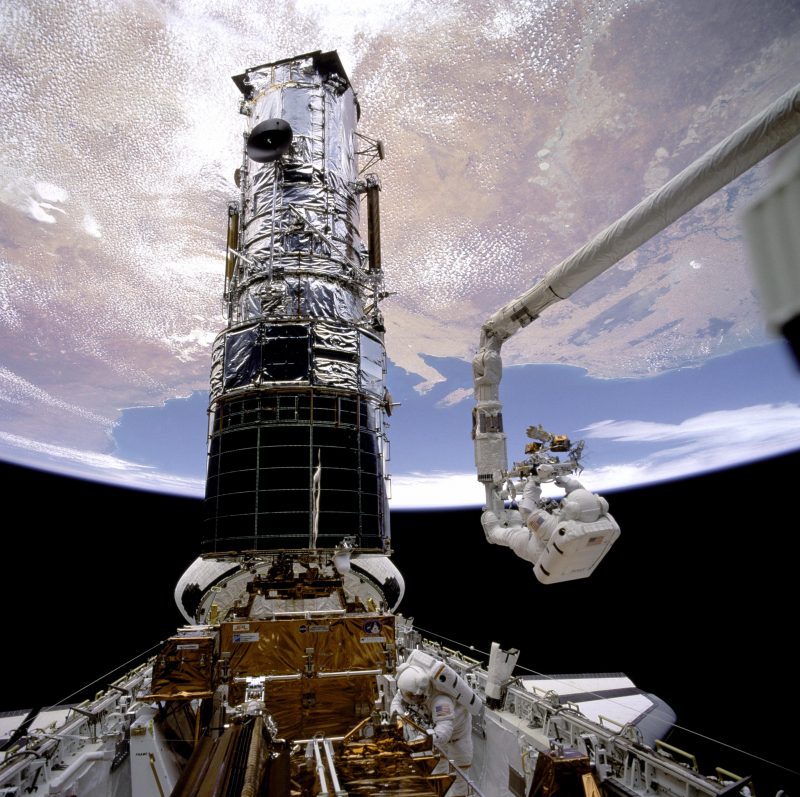
A boost to extend Hubble’s life
NASA and SpaceX announced on September 29, 2022, that they intend to spend 6 months studying how a SpaceX Dragon spacecraft might return the Hubble Space Telescope to its original orbit. The boost would extend the telescope’s life by a decade or more. It could be the most exciting manned near-Earth mission since astronauts repaired the nearsightedness of the orbiting telescope in 1993. And it would happen “at no cost to the government,” the announcement said. It said:
NASA and SpaceX signed an unfunded Space Act Agreement Thursday, September 22, 2022, to study the feasibility of the SpaceX and Polaris idea to boost the agency’s Hubble Space Telescope into a higher orbit with the Dragon spacecraft, at no cost to the government.
Billionaire businessman Jared Isaacman – who founded the Polaris Program, a human spaceflight program – participated in the September 29 announcement.
Upgrading the telescope’s scientific instruments might also be possible, they said.
Hubble is falling … Very slowly
When first placed in orbit in 1990, the HST rode at about 380 miles (600 km) above the Earth’s surface. Since then, the almost nonexistent atmosphere at that height above Earth has gently but persistently tugged at the telescope. At a media briefing to discuss the study, HST project manager Patrick Crouse said:
So even though Hubble has been on orbit for over 32 years, its orbit was originally about 380 miles above Earth and has slowly decayed over time due to atmospheric drag. So, its current orbit is about 335 miles.
Hubble will eventually burn on reentry, Crouse said:
Right now, the last prediction we had, last year, was that we had a 50-percent probability of reentry in 2037.
If a mission to prevent that doom flies, then Crouse said, mission controllers will also discuss enhancing Hubble’s instruments. No specific alterations to the telescope are being considered.
Billionaire paying for the flight
The Hubble has been serviced five times, and NASA has no plans for a 6th visit. But it soon might, according to Jared Isaacman, commercial astronaut and commander of Polaris Dawn, who also participated in the briefing:
The idea is this is a study at this point, not just for Hubble, but just broad applicability of these types of potential servicing missions in low-Earth orbit. That stated, if the study takes us down a path where a mission is possible, this would certainly fit within the kind of parameters we’ve established for the Polaris Program and certainly would build upon the Polaris Dawn foundation.
While Isaacman is one of the world’s first commercial astronauts, he’s also a billionaire businessman who has purchased three SpaceX flights for what he calls the Polaris Program. The space flights are intended to demonstrate new tech and do on-orbit research. The third mission of the program will be the first manned mission of the SpaceX Starship.
If one of the three Polaris Program flights is given over to an HST visit, then that organization will foot the bill.
Hubble is A-OK
At the start of the briefing, Thomas Zurbuchen, associate administrator of NASA’s Science Mission Directorate reiterated there is nothing wrong with the scope:
Hubble is amazingly successful. It’s healthy. It’s doing great science as we speak.
But he also said studying “crazy things” is one of the things his division of NASA is tasked to do, even if they’re not quite ready to do them:
We want to know what the possibilities are. I want to be absolutely clear, we’re not making any announcement today that we’re definitely going forward with a plan like this.
What are they studying?
The six months will be spent figuring out if what the group is proposing can even be pulled off.
Jessica Jensen, a vice president for SpaceX, described the company’s role:
Predominantly on the SpaceX side, we’re going to be looking at Dragon capabilities and how they would need to be modified in order to safely rendezvous and dock with Hubble. Details of how exactly physically that’s done and also how we safely do that from a trajectory point of view, that’s all to be worked out.
And while there is no plan yet for a journey to the Hubble, all the details – including a timeline – will be worked out for one by the study’s end, Jansen said:
Part of this is going to be figuring out the cost and figuring out a little bit of a schedule, what it’s going to take to actually make this happen and make it happen safely. We don’t want to do something that’s going to put Hubble at risk at all.
Bottom line: NASA and SpaceX are studying a mission to boost the orbit of the Hubble Space Telescope.











